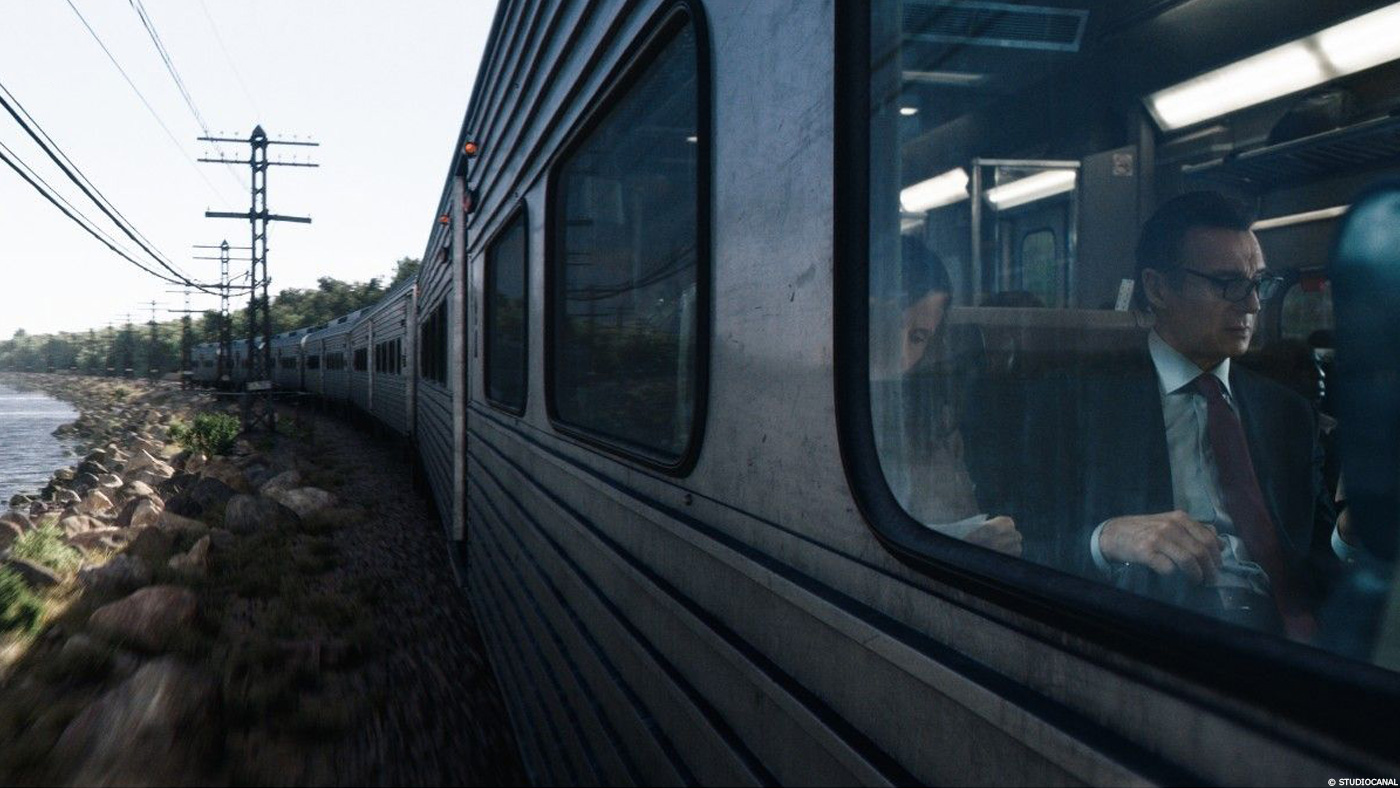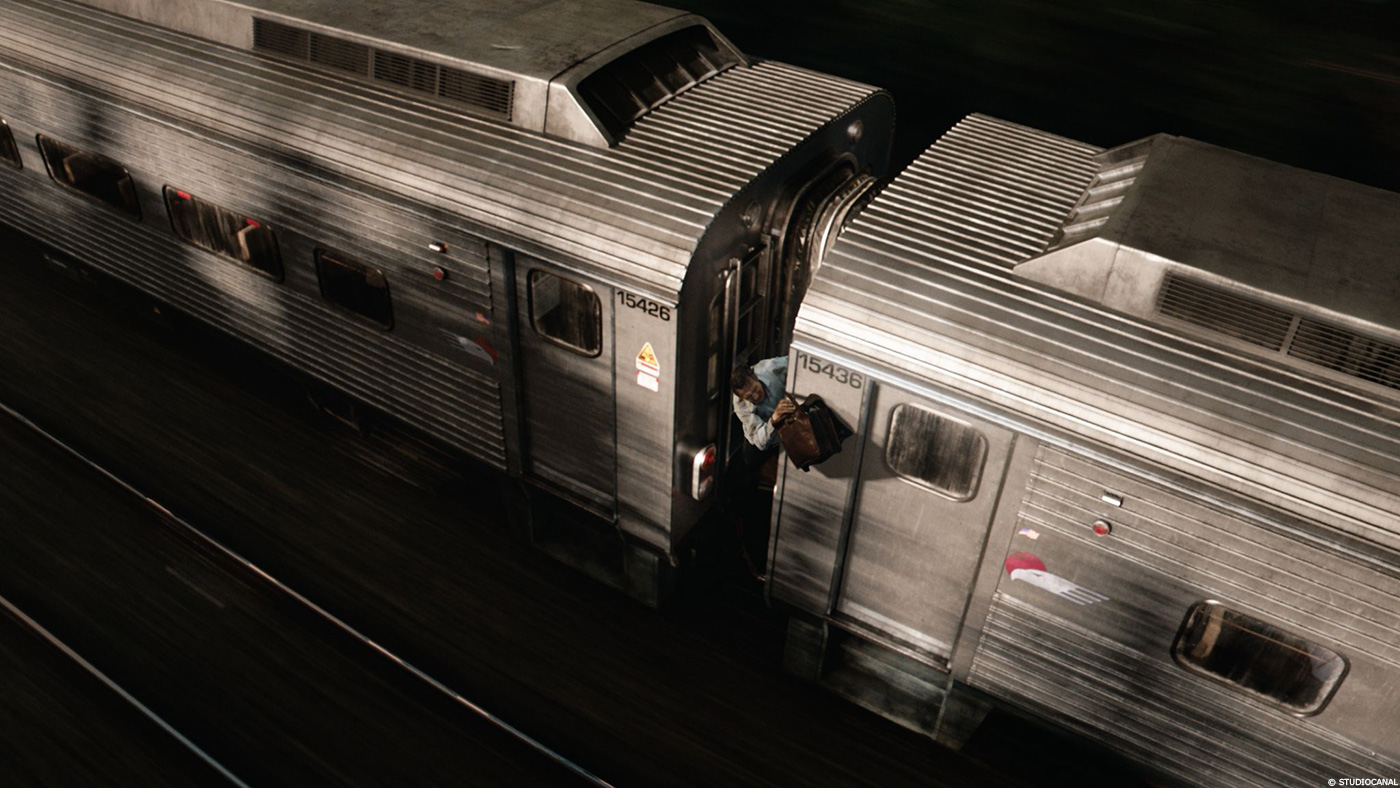In 2015, Steve Begg explained his work on SPECTRE. He talks to us today about his work on THE COMMUTER.
How did you get involved on this show?
The exec producer Michael Dreyer contacted me to see initially if I would consult on it. When I took a closer look I thought it would suit me as the bulk of the shoot was in the UK where I wanted to be for personal reasons that year. However I nearly walked when I found out they had no plans to shoot a real train at all and wanted use CG for all exterior shots thinking it would make life easier, (obviously not for the vfx dept). I thought that’s a hell of a lot of work for mundane shots but decided to stick with it.
How was your collaboration with director Jaume Collet-Serra?
I thought it was pretty good ultimately although I think he was initially a bit suspicious of my involvement on a project that was a lot smaller scale wise than the recent productions I’d been on. He thought I was after an easy run which I was, but it became quite a monster as it went along.
What was his approach and expectations on the shots?
There were planned shots but it was pretty much spontaneous and made up on the spot like most directors do these days. I just had to be ready and damage limit the shoot making sure we got all we needed. He’s got a great inventive eye so we tried as much as possible to match his style in the VFX shots and elements.
How did you organize the work with your VFX Producer Rupert Smith?
Rupert took care of the VFX dept organizing personnel and finances, and coordinated the work flow to the VFX vendors. I took care of the shoot and dealt with the director, then worked with the technical / creative issues with the vendors.
Can you tell us more about the previz and postviz work?
Nvizible handled all the initial previs doing a great job in their first pass on the train crash. Also the Grand Central Station shot was one of their babies. I’d block everything out then send it to Jaume for feedback initially, but the final train crash layout was done by Jaume at Cinesite.
Post viz was handled by Matt Tinsley, Jack Hughes and Paul Docherty where they selected and precomped the background footage on Quicktimes for previews and director screenings, which then helped to select background material for the final composites.
There is a beautiful time-lapse shot in Grand Central Station. How was it filmed and created?
That was a monster shot. As I said we got some previs from Nvizible and thankfully we stuck with that as a basic model. During the shot Liam undergoes six changes in clothes in a rhythmic jump cut effect. So the plan was to shoot Liam with Moco six times and pray he’d hit the mark which I couldn’t believe he would, so the backup was to replace Liam with CG at a certain point. Jaume was insistent he would match up and he was correct beyond my expectations. There was none the less a fair amount of cut and paste to help the alignment. A minimal set was built of just the main circular information booth and 60ft of tiled floor, the rest of the environment rendered in CG culled from reference and texture photos taken during clandestine still shoots at the actual Grand Central location. I say ‘Clandestine’ as the Hudson line railway authorities decided to be a bit unhelpful due to the fact the movie featured a train crash, something they were unfortunately a bit sensitive to as they had suffered one recently for real. Multiple passes of the other commuters were shot a varying frame rates from 24-4 fps which would also be jump cut in speed. At the fastest point fully CG people would then be used with appropriate motion streaking then fade into nothingness.
Let’s talk about the train. How did you proceed to get the informations to recreate it in CG?
We managed to get access to similar trains which are all basically generic and the textures and measurements where acquired from those. When we go from a CG exterior to an interior set piece the geometry had to be modified slightly to accommodate the slightly larger than life movie proportions of the set.
The train is seen in various lighting conditions. How did you handle this challenge?
Some of the aerial plates actually featured a train in order to line up and compose the shot. These where then used a guide to lighting and comping the CG movie train which was overlayed on top. However most of the shots featured empty tracks so it was done by the mastery of the lighting and compositing teams.
What was your approach for the background elements in the train?
I felt strongly that the background elements have similar lighting and direction of light to the foreground set. I’m always surprised how that is often overlooked even in car shots. I even got Cinesite to add mid distance 2.5D objects (telegraph posts etc) to certain plates in order to look like they just caused the practical shadows that swept through the set supplied by the DOP.
Can you tell us more about how you filmed and created these background plates?
Well we initially opted for a full 360 degree camera array on a flatbed railway trailer which was an option for a bit then was refused due to health and safety concerns (what else?), then we were offered a carriage killing the full setup of camera’s thanks to the carriage window layout. We could get a three camera setup out of the larger side windows offering 120-140 degrees FOV after the stitch, and some single wide angle cameras for forward and reverse views so we went with that initially. After the directors cut was done we could accurately identify the backgrounds that were still missing or needed and went for a second plate shoot this time from a low loader on a road as we didn’t need to see railway paraphernalia. I abandoned the camera array approach and went for an 8k wide angle Red Epic shoot which worked well. We even used some Canon 5d material shot on a recce when we found out we didn’t have proper material for one angle.
The backgrounds for the Underground sequences at the beginning of the movie were fully CG due to the fact there was nothing really interesting to photograph down there for real other that dirty grubby walls and we needed full control of the exterior to interact with the foreground lighting effects (Passing signals, flashing lights etc) once again supplied by the DOP on set.
Did you received specific indications or reference for the train crash?
None really other than looking at great crashes in previous movies, the best one being in THE FUGITIVE followed by the one in SUPER 8.
Were you able to shoot some miniatures elements for the crash?
Well at one point Jaume asked me about miniatures and I would have loved to have gone that route but it would have meant building a miniature train quarter or fifth scale about 100ft long then a stage or area big enough to shoot it on then at least 2 times that length in track to get it up to speed before the filming crash area. Plus we would have wanted to do more than one take. So that went out the window and we went CG also because of some of the wild camera angles he wanted. Some fire and dust elements were shot to help.
Can you tell us how you choose the various VFX vendors?
I felt because of the train crash and the mass of tricky window shots that a smaller vendor or a couple of small vendors weren’t really the option so I decided to go with Cinesite London with whom I’ve had a good relationship with in the past, and has the extra firepower of their Montreal division. I didn’t want to go with one of the bigger vendors and get lost in their pipeline, and felt that Cinesite were just the right scale to respect the project.
Can you tell us more about your collaboration with their VFX supervisors?
I was fortunate to get a chap called Stephane Paris who fronted the Cinesite work who has a wealth of 3D experience and also was good to have on the stage and got used to rolling with the punches on the main shoot.
Iloura came on late and handled a good chunk of window work and got up to speed real quick delivering first pass finals straight away, and Nvizible handle a half dozen cool futuristic sniper gunsight graphics for the end of the movie.
The vendors are all around the world. How did you proceed to follow their work?
The usual, cineSyncs and conference calls.
Which sequence or shot was the most complicated to create and why?
Probably when Micheal is escaping from the train and rolls between the wheels and has to run alongside it and get back on-board… Basically there was twenty feet of track and sleepers and a tiny part of the underside of the train for him to fall out of and nothing else. Absolutely everything that Liam doesn’t come in contact with didn’t exist and was posted in after. So all the wheels, bogies, carriage underside, local environment and track extensions all added in by Cinesite. When Liam is running after the train and manages to jump back on all we had was a grey covered truck in the car park in Pinewood with him running alongside and jumping onto it. The only real element is Liam!
What is your favorite shot or sequence?
The opening montage is quite beautiful illustrating the mundane repetitiveness of Micheal’s commute over a year. There’s a lot of subtle VFX and matte work changing the seasonal weather and environments in the backgrounds… From winter to summer and back… Music’s nice too…
What is your best memory on this show?
Being left alone to get on with the VFX… Apart from the nearby cutting room we were pretty much left alone to get on with stuff apart from the occasional visits over the months of post from Jauma and the producers who were mostly based in the States. At the end it was just a couple of cineSyncs a week with the director.
How long have you worked on this show?
I started April 2016 finishing August 2017.
What’s the VFX shots count?
1400 approx, the greatest bulk of which were window shots.
What was the size of your on-set team?
Pretty small. One regular data wrangler who was also our eyes and ears for the invented shots if I wasn’t around and a representative of Cinesite, usually Stephane Paris.
What is your next project?
THE COMMUTER 2 (The return ticket) 😉
A big thanks for your time.
© Vincent Frei – The Art of VFX – 2018











